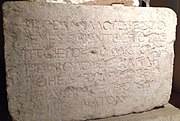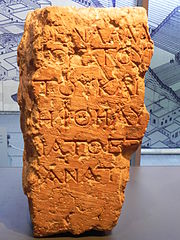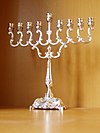|
Temple in Jerusalem
The Temple in Jerusalem, or alternatively the Holy Temple (Hebrew: בֵּית־הַמִּקְדָּשׁ, Modern: Bēt haMīqdaš, Tiberian: Bēṯ hamMīqdāš; Arabic: بيت المقدس, Bayt al-Maqdis), refers to the two religious structures that served as the central places of worship for Israelites and Jews on the modern-day Temple Mount in the Old City of Jerusalem. According to the Hebrew Bible, the First Temple was built in the 10th century BCE, during the reign of Solomon over the United Kingdom of Israel. It stood until c. 587 BCE, when it was destroyed during the Babylonian siege of Jerusalem.[1] Almost a century later, the First Temple was replaced by the Second Temple, which was built after the Neo-Babylonian Empire was conquered by the Achaemenid Persian Empire. While the Second Temple stood for a longer period of time than the First Temple, it was likewise destroyed during the Roman siege of Jerusalem in 70 CE. Projects to build the hypothetical "Third Temple" have not come to fruition in the modern era, though the Temple in Jerusalem still features prominently in Judaism.[2] As an object of longing and a symbol of future redemption, the Temple has been commemorated in Jewish tradition through prayer, liturgical poetry, art, poetry, architecture, and other forms of expression. Outside of Judaism, the Temple (and today's Temple Mount) also carries a high level of significance in Islam and Christianity. One of the early Arabic names for Jerusalem is Bayt al-Maqdis, which preserves the memory of the Temple. The Temple Mount is home to two monumental Islamic structures, the Dome of the Rock and Al-Aqsa Mosque, which date to the Umayyad period. The site, known to Muslims as the "Al-Aqsa Mosque compound" or Haram al-Sharif, is considered the third-holiest site in Islam. The Christian New Testament and tradition hold that important events in Jesus' life took place in the Temple, and the Crusaders attributed the name "Templum Domini" ("Temple of the Lord") to the Dome of the Rock. EtymologyThe Hebrew name given in the Hebrew Bible for the building complex is either Mikdash (Hebrew: מקדש), as used in Exodus,[3] or simply Bayt / Beit Adonai (Hebrew: בית), as used in 1 Chronicles.[4] In rabbinic literature, the temple sanctuary is called Beit HaMikdash (Hebrew: בית המקדש), meaning, "The Holy House", and only the Temple in Jerusalem is referred to by this name.[5][better source needed] In classic English texts, however, the word "Temple" is used interchangeably, sometimes having the strict connotation of the Temple precincts, with its courts (Greek: ἱερὸν), while at other times having the strict connotation of the Temple Sanctuary (Greek: ναός).[6] While Greek and Hebrew texts make this distinction, English texts do not always do so. Jewish rabbi and philosopher Maimonides gave the following definition of "Temple" in his Mishne Torah (Hil. Beit Ha-Bechirah):
First Temple The Hebrew Bible says that the First Temple was built by King Solomon,[9] completed in 957 BCE.[10] According to the Book of Deuteronomy, as the sole place of Israelite korban (sacrifice),[11] the Temple replaced the Tabernacle constructed in the Sinai under the auspices of Moses, as well as local sanctuaries, and altars in the hills.[12] This Temple was sacked a few decades later by Shoshenq I, Pharaoh of Egypt.[13] Although efforts were made at partial reconstruction, it was only in 835 BCE when Jehoash, King of Judah, in the second year of his reign invested considerable sums in reconstruction, only to have it stripped again for Sennacherib, King of Assyria c. 700 BCE.[citation needed] The First Temple was totally destroyed in the Siege of Jerusalem by the Neo-Babylonian Empire in 586 BCE.[c] Second Temple According to the Book of Ezra, construction of the Second Temple was called for by Cyrus the Great and began in 538 BCE,[14] after the fall of the Neo-Babylonian Empire the year before.[15] According to some 19th-century calculations, work started later, in April 536 BCE[16] and was completed on 21 February, 515 BCE, 21 years after the start of the construction. This date is obtained by coordinating Ezra 3:8–10[17] (the third day of Adar, in the sixth year of the reign of Darius the Great) with historical sources.[18] The accuracy of these dates is contested by some modern researchers, who consider the biblical text to be of later date and based on a combination of historical records and religious considerations, leading to contradictions between different books of the Bible and making the dates unreliable.[19] The new temple was dedicated by the Jewish governor Zerubbabel. However, with a full reading of the Book of Ezra and the Book of Nehemiah, there were four edicts to build the Second Temple, which were issued by three kings: Cyrus in 536 BCE (Ezra ch. 1), Darius I of Persia in 519 BCE (ch. 6), and Artaxerxes I of Persia in 457 BCE (ch. 7), and finally by Artaxerxes again in 444 BCE (Nehemiah ch. 2).[20] According to classical Jewish sources, another demolition of the Temple was narrowly avoided in 332 BCE when the Jews refused to acknowledge the deification of Alexander the Great of Macedonia, but Alexander was placated at the last minute by astute diplomacy and flattery.[21] After Jerusalem came under Seleucid rule, Antiochus III attempted to introduce the Greek pantheon into the temple. A rebellion ensued and was brutally crushed, but no further action by Antiochus was taken. When Antiochus IV Epiphanes assumed the Seleucid thrown he immediately attempted to enforce universal Hellenization once again. During this time, several incidents considered offensive under traditional Jewish practice occurred in the temple, to include erecting a statute of Zeus and the sacrifice of pigs. This led to a two year civil war in Judea in which traditionalist rebels led by Mattathias fought against both Seleucid forces and the Hellenized Judean forces who administered Judea in Antiochus's name. After the rebels successfully overthrew Seleucid rule, Mattathias' son Judah Maccabee re-dedicated the temple in 164 BCE, giving rise to the celebration of Hanukkah.[9] During the Roman era, Pompey entered (and thereby desecrated) the Holy of Holies in 63 BCE, but left the Temple intact.[22][23][24] In 54 BCE, Crassus looted the Temple treasury.[25][26] Around 20 BCE, the building was renovated and expanded by Herod the Great, and became known as Herod's Temple. It was destroyed by the Romans in 70 CE during the Siege of Jerusalem. During the Bar Kokhba revolt against the Romans in 132–135 CE, Simon bar Kokhba and Rabbi Akiva wanted to rebuild the Temple, but bar Kokhba's revolt failed and the Jews were banned from Jerusalem (except for Tisha B'Av) by the Roman Empire. The emperor Julian allowed the Temple to be rebuilt, but the Galilee earthquake of 363 ended all attempts ever since.[citation needed] Al-Aqsa and the Third TempleBy the 7th century, the site had fallen into disrepair under Byzantine rule. After the Muslim conquest of Jerusalem in the 7th century during the Rashidun Caliphate, a mosque was built by caliph Umar ibn al-Khattab (reigned 634–644 CE) who first cleared the site of debris and then erected a mihrab and simple mosque on the same site as the present mosque. This first mosque construction was known as Masjid al-'Umari. During the Umayyad caliphate, the caliph Abd al-Malik ibn Marwan ordered a renovation of the Islamic mosque, constructing the Dome of the Rock, on the Temple Mount. The mosque has stood on the mount since 691 CE; the Jami Al-Aqsa. It has been renovated several times since, including during the Abbasid, Fatimid, Mamluk, and Ottoman eras.[27] Archaeological evidenceFragment of the Temple Warning Inscription at the Israel Museum. The Trumpeting Place inscription, a stone (2.43×1 m) with Hebrew writing "To the Trumpeting Place" uncovered during archaeological excavations by Benjamin Mazar at the southern foot of the Temple Mount is believed to be a part of the complex of the Second Temple. Archaeological excavations have found remnants of both the First Temple and the Second Temple. Among the artifacts of the First Temple are dozens of ritual immersion pools in this area surrounding the Temple Mount,[28] as well as a large square platform identified by architectural archaeologist Leen Ritmeyer as likely being built by King Hezekiah c. 700 BCE as a gathering area in front of the Temple. Concrete finds from the Second Temple include the Temple Warning inscriptions and the Trumpeting Place inscription, two surviving pieces of the Herodian expansion of the Temple Mount. The Temple Warning inscriptions forbid the entry of pagans to the Temple, a prohibition also mentioned by the 1st century CE historian Josephus. These inscriptions were on the wall that surrounded the Temple and prevented non-Jews from entering the temple's courtyard. The Trumpeting Place inscription was found at the southwest corner of Temple Mount, and is believed to mark the site where the priests used to declare the advent of Shabbat and other Jewish holidays.[29] Ritual objects used in the temple service were carried off and many are likely located in museum collections, in particular, that of the Vatican Museums.[30] Location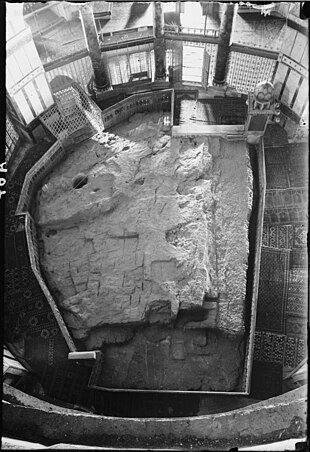  There are three main theories as to where the Temple stood: where the Dome of the Rock is now located, to the north of the Dome of the Rock (Professor Asher Kaufman), or to the east of the Dome of the Rock (Professor Joseph Patrich of the Hebrew University).[31] In the TalmudSeder Kodashim, the fifth order, or division, of the Mishnah (compiled between 200 and 220 CE), provides detailed descriptions and discussions of the religious laws connected with Temple service including the sacrifices, the Temple and its furnishings, as well as the priests who carried out the duties and ceremonies of its service. Tractates of the order deal with the sacrifices of animals, birds, and meal offerings, the laws of bringing a sacrifice, such as the sin offering and the guilt offering, and the laws of misappropriation of sacred property. In addition, the order contains a description of the Second Temple (tractate Middot), and a description and rules about the daily sacrifice service in the Temple (tractate Tamid).[32][33][34] In the Babylonian Talmud, all the tractates have Gemara – rabbinical commentary and analysis – for all their chapters; some chapters of Tamid, and none on Middot and Kinnim. The Jerusalem Talmud has no Gemara on any of the tractates of Kodashim.[33][34] Recent historyThe Temple Mount, along with the entire Old City of Jerusalem, was captured from Jordan by Israel in 1967 during the Six-Day War, allowing Jews once again to visit the holy site.[35][36][better source needed] Jordan had occupied East Jerusalem and the Temple Mount immediately following Israel's declaration of independence on May 14, 1948. Israel officially unified East Jerusalem, including the Temple Mount, with the rest of Jerusalem in 1980 under the Jerusalem Law, though United Nations Security Council Resolution 478 declared the Jerusalem Law to be in violation of international law.[citation needed] The Jerusalem Islamic Waqf, based in Jordan, has administrative control of the Temple Mount. In other religionsChristianity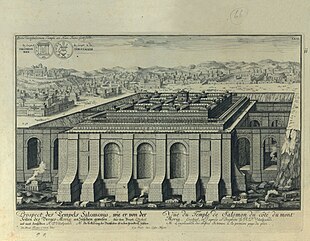 According to Matthew 24:2,[37] Jesus predicts the destruction of the Second Temple. This idea, of the Temple as the body of Christ, became a rich and multi-layered theme in medieval Christian thought (where Temple/body can be the heavenly body of Christ, the ecclesial body of the Church, and the Eucharistic body on the altar).[38] IslamThe Temple Mount bears significance in Islam as it acted as a sanctuary for the Hebrew prophets and the Israelites. Islamic tradition says that a temple was first built on the Temple Mount by Solomon, the son of David. After the destruction of the second temple, it was rebuilt by the second Rashidun Caliph, Omar, which stands until today as Al-Aqsa Mosque. Traditionally referred to as the "Farthest Mosque" (al-masjid al-aqṣa' literally "utmost site of bowing (in worship)" though the term now refers specifically to the mosque in the southern wall of the compound which today is known simply as al-haram ash-sharīf "the noble sanctuary"), the site is seen as the destination of Muhammad's Night Journey, one of the most significant events recounted in the Quran and the place of his ascent heavenwards thereafter (Mi'raj). Muslims view the Temple in Jerusalem as their inheritance, being the followers of the last prophet of God and believers in every prophet sent, including the prophets Moses and Solomon. To Muslims, Al-Aqsa Mosque is not built on top of the temple, rather, it is the Third Temple, and they are the true believers who worship in it, whereas Jews and Christians are disbelievers who do not believe in God's final prophets Jesus and Muhammad.[39][40] In Islam, Muslims are encouraged to visit Jerusalem and pray at Al-Aqsa Mosque. There are over forty hadith about Al-Aqsa Mosque and the virtue of visiting and praying in it, or at least sending oil to light its lamps. In a hadith compiled by Al-Tabarani, Bayhaqi, and Suyuti, the Prophet Muhammad said, "A prayer in Makkah (Ka’bah) is worth 1,000,000 times (reward), a prayer in my mosque (Madinah) is worth 1,000 times and a prayer in Al-Aqsa Sanctuary is worth 500 times more reward than anywhere else." Another hadith compiled by imams Muhammad al-Bukhari, Muslim, and Abu Dawud expounds on the importance of visiting the holy site. In another hadith the prophet Muhammad said, "You should not undertake a special journey to visit any place other than the following three Masjids with the expectations of getting greater reward: the Sacred Masjid of Makkah (Ka’bah), this Masjid of mine (the Prophet’s Masjid in Madinah), and Masjid Al-Aqsa (of Jerusalem)."[41] According to Seyyed Hossein Nasr, professor of Islamic Studies at George Washington University, Jerusalem (i.e., the Temple Mount) has the significance as a holy site/sanctuary ("haram") for Muslims primarily in three ways, the first two being connected to the Temple.[42] First, Muhammad (and his companions) prayed facing the Temple in Jerusalem (referred to as "Bayt Al-Maqdis", in the Hadiths) similar to the Jews before changing it to the Kaaba in Mecca sixteen months after arriving in Medina following the verses revealed (Sura 2:144, 149–150). Secondly, during the Meccan part of his life, he reported to have been to Jerusalem by night and prayed in the Temple, as the first part of his otherworldly journey (Isra and Mi'raj). Imam Abdul Hadi Palazzi, leader of Italian Muslim Assembly, quotes the Quran to support Judaism's special connection to the Temple Mount. According to Palazzi, "The most authoritative Islamic sources affirm the Temples". He adds that Jerusalem is sacred to Muslims because of its prior holiness to Jews and its standing as home to the biblical prophets and kings David and Solomon, all of whom he says are sacred figures in Islam. He claims that the Quran "expressly recognizes that Jerusalem plays the same role for Jews that Mecca has for Muslims".[43] Building a Third Temple 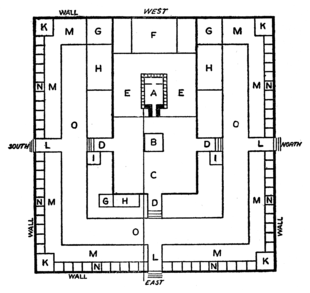 Ever since the Second Temple's destruction, a prayer for the construction of a Third Temple has been a formal and mandatory part of the thrice-daily Jewish prayer services. However, the question of whether and when to construct the Third Temple is disputed both within the Jewish community and without; groups within Judaism argue both for and against construction of a new Temple, while the expansion of Abrahamic religion since the 1st century CE has made the issue contentious within Christian and Islamic thought as well. Furthermore, the complicated political status of Jerusalem makes reconstruction difficult, while Al-Aqsa Mosque and the Dome of the Rock have been constructed at the traditional physical location of the Temple. In 363 CE, the Roman emperor Julian had ordered Alypius of Antioch to rebuild the Temple as part of his campaign to strengthen non-Christian religions.[44] The attempt failed, with contemporary accounts mentioning divine fire falling from Heaven but also perhaps due to sabotage, an accidental fire, or an earthquake in Galilee. The Book of Ezekiel prophesies what would be the Third Temple, noting it as an eternal house of prayer and describing it in detail. See also
Notes
References
Further reading
|

